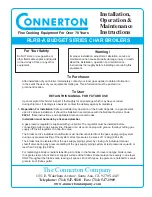
Lx – WH Series Installation and Operation Instructions
│
Trinity Lx
49
Tank Temperature and Pressure Relief Valve -
The storage tank will require a temperature and pressure relief
valve sized to ASME specifications and t
hat complies with the Standard for Relief Valves for Hot Water
Supply Systems, ANSI Z21.22•CSA 4.4. The relief valve is to be installed on the storage tank in accordance
with Figure 10-2 and must be accessible for servicing or replacement.
No valve is to be place between the
T&P Relief Valve and the storage tank. Check if local codes require storage tanks to have any additional
valves.
Ensure the discharge of the temperature and pressure relief valve is piped to a drain or a
location where steam or water will not cause property damage, serious injury or death.
Tank Thermostat (Aquastat) -
The aquastat is intended to allow the water heater to monitor and control tank
temperature, improve response time, and prevent short cycles of operation. Check that the aquastat will mate
with the tapping on the storage tank prior to commencing installation. Install the aquastat in the storage tank
as per the manufactures’ instructions. Refer to Section 12.0 Field Wiring for details.
Tank Sensor
– In lieu of a Tank Thermostat, the Lx water heater control can monitor a tank sensor installed in
the storage tank. When a tank sensor is used, the tank temperature is set via the Lx control; burner demands
are generated directly by the Lx controller based on controller settings.
Tank sensor
MUST
be used in conjunction with a DHW temperature safety shutoff
switch. NTI recommends using P/N 84632 (Tank Sensor w/integrated safety switch).
Failure to provide such a switch may result in property damage, serious injury to
occupants, or possibly death.
Thermostatic (Anti-Scald) Mixing Valve -
An anti-scald mixing valve is recommended when storing domestic
hot water above 4
6
°
C (
115°F) and should be used on branches supplying low temperature water to endpoint
plumbing fixtures. A mixing valve is optional on high temperature water applications, including but not
limited to process water, clothes washers, dishwashers or sanitizers, depending on the temperature desired at
the appliance and water storage temperature.
When the system requires water at temperatures higher than required for other uses, a
means such as a mixing valve shall be installed to temper the water for those uses in
order to reduce scald hazard potential. Failure to follow these instructions may result in
serious injury or death.
Figure 10-2: Stand Alone Water Heater Applications -
This piping diagram demonstrates an application with
both low temperature requirements, such as bathing, and high temperature requirements, such as commercial
process water heating or laundry. When the system requires water at temperatures higher than required for
other uses, a thermostatic (anti-scald) mixing valve shall be installed to temper the water for those uses in
order to reduce scald hazard potential, see Table 10-1. An optional DHW Recirculation Return may be used
on long plumbing runs to prevent wait times for hot water on both low and high temperature water
applications. Refer to Section 12.0 for field wiring instructions.
The Water Heater Circulator (Pump B) must be sized according to Table 10-5 to provide
adequate circulation through the water heater.
Figure 10-2 illustrates a typical piping system. The Water Heater Plumbing Schematic
does not illustrate all of the required concepts and components required to have a proper
installation. Concepts not shown include: prevention of thermal-siphoning (i.e. heat
traps), isolation valves, drain and purge valves, etc. It is the responsibility of the
installing contractor and system designer to consider all aspects of a proper system
design including compliance with local codes. Contractor modifications to these
instructions may be required, based upon existing piping and system design.
Energy Efficiency
- Although the Trinity Lx Water Heater is an energy efficient appliance, insulating long pipe
runs can improve the overall system efficiency by conserving energy and reducing standby losses.
















































